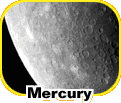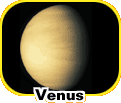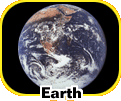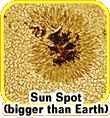

Hey, Stella Stardust here. Welcome to another cosmic conversation. Let’s give a warm welcome to the Sun !
STELLA: You know, everyone here on Earth loves your work. If it weren’t for you, we wouldn’t be here.
SUN: Thanks, Stella. I’ve been cranking out energy for billions of years—and not one day off.
STELLA: Impressive. Your agent told me that you’re the biggest star in the universe . Is that true?
SUN: Actually, no. My agent tends to exaggerate. I’m just a medium-sized star. To my fans on Earth, I look much bigger than the other stars in the sky. That’s because I’m much closer to you than the other stars. I’m 93 million miles away from you. The bigger stars are millions of times farther away from your planet.
STELLA: I can’t believe it. You, the Sun, are just an average, ordinary, run-of-the-mill star!
SUN: Hey, take it easy. I may be an average star, but I’m still a LOT bigger than your puny planet. Guess how many Earth-sized planets could fit inside me?
STELLA: I don’t know. Maybe ten?
SUN: Not even close! More than a million! I'm big and I've got lots of mass. That's why I've got a lot of gravity. You guys don’t call this the Solar system for nothing. "Solar" means "sun." This is my show. All the planets, comets, and asteroids orbit around ME.
STELLA: I know you star types tend to be touchy about age, but how old are you?
SUN: Well, I began shining about 4.6 billion years ago. It was so long ago I don’t remember the exact day.
STELLA: Was it a Sunday? Just kidding. Actually, I’m curious to know how stars begin. What’s your story?
SUN: We stars begin as huge spinning clouds of gas and dust. Gravity pulls the gas and dust together in round clumps, which get hot. At that point, we're called protostars. Eventually we get hot enough to start fusing hydrogen atoms together, which releases energy. Then we really shine. Stars are born in batches, which are like star nurseries. Then, over millions of years, these stars drift apart and spread out around the galaxy.
STELLA: Let’s turn to a delicate subject. How do stars die?
SUN: After stars like me shine for billions of years, we eventually run out of fuel. When that happens, we swell up as much as 100 times bigger and are called red giants. Astronomers predict that I’ll eventually become a red giant. At that time, my heat will vaporize the inner planets - Mercury , Venus , and Earth .



STELLA: That sounds really scary.
SUN: Don’t worry. That won’t happen for about 5 billion years! After I become a red giant, I’ll lose my outer gas layers and reveal my inner core, known as a white dwarf. When I’m a white dwarf, I’ll be only as big as Earth, but still very hot, and very dense. Finally, I’ll cool down and disappear from view.
STELLA: I hear that some stars die differently. What’s a supernova?
SUN: When a star more massive than I gets old and runs out of nuclear fuel, it blows up in a great flash of light called a supernova. This explosion splatters the star’s guts in all directions.

STELLA: I’d like to show the people at home a picture of a star that exploded as a supernova. Its remains are called the Crab Nebula.
SUN: What a mess that star made. Want to know something amazing? Humans saw this star explode in the year 1054. But the explosion actually happened about 6,000 years before that.
STELLA: Huh?
SUN: I’ll explain. Stars give off light, right? Light travels incredibly fast - at a speed of 186,000 miles per second. Light can travel from Earth to the Moon in about one second. My sunlight reaches you Earthlings in about eight minutes. Most stars are much farther away. That’s why astronomers don’t use miles when they talk about the distances between stars. That’s like describing the distance between New York and Los Angeles in inches! Astronomers talk about light-years. A light-year is the distance light travels in one year. Since the star in that picture was about 6,000 light-years away from Earth when it exploded, it took about 6,000 years for us to get the “newsflash.”
STELLA: In Hollywood, I meet a lot of people filled with hot air. What gases are inside you?
SUN: Ah, you want to know what gives me that special glow! Well, like most other stars, I’m made up of mostly two gases, hydrogen and helium. These light gases stay close to me because of my massive gravity. Inside, I’m so hot that I use a fancy process called thermonuclear fusion. By turning hydrogen into helium, I create lots of energy. It makes me shine.

STELLA: This may be a little rude, but what are those dark splotches on you? Are those, like, star “zits”?
SUN: (sigh) No, those dark splotches are called sunspots . All normal stars have them. They look dark because they’re cooler than the gases around them. By the way, when I say “cooler,” keep in mind that my outside is about 10,000o F. That’s many times hotter than the hottest kitchen oven. My inner core is even hotter, something like 30,000,000o F.

STELLA: Is there anything else you’d like to say?
SUN: You think your sunglasses are “star-shaped,” right?
STELLA: Sure.
SUN: Well, if they were really “star-shaped,” they’d be round. You Earthlings have the strange idea that stars have points. We don’t. Gravity keeps us shaped like spheres.
STELLA: Thanks to the Sun for a great interview. Good night.
Image Credits:
Photos: Venus: courtesy of Bill Shoening, AURA/NOAO/NSF; Galaxy in montage: courtesy of STScI; Planets in montage: courtesy of NASA, Voyager 2; Kids: courtesy of Denis Finnin, AMNH; Illustrations: Stella Stardust: Jim Steck; Milky Way Galaxy: Denis Davidson




 Biodiversity
Biodiversity
 Brain
Brain
 Genetics
Genetics
 Marine BiOLogy
Marine BiOLogy
 MicrobiOLogy
MicrobiOLogy
 PaleontOLogy
PaleontOLogy
 ZoOLogy
ZoOLogy
 AnthropOLogy
AnthropOLogy
 ArchaeOLogy
ArchaeOLogy
 Astronomy
Astronomy
 Climate Change
Climate Change
 Earth
Earth
 Physics
Physics
 Water
Water
